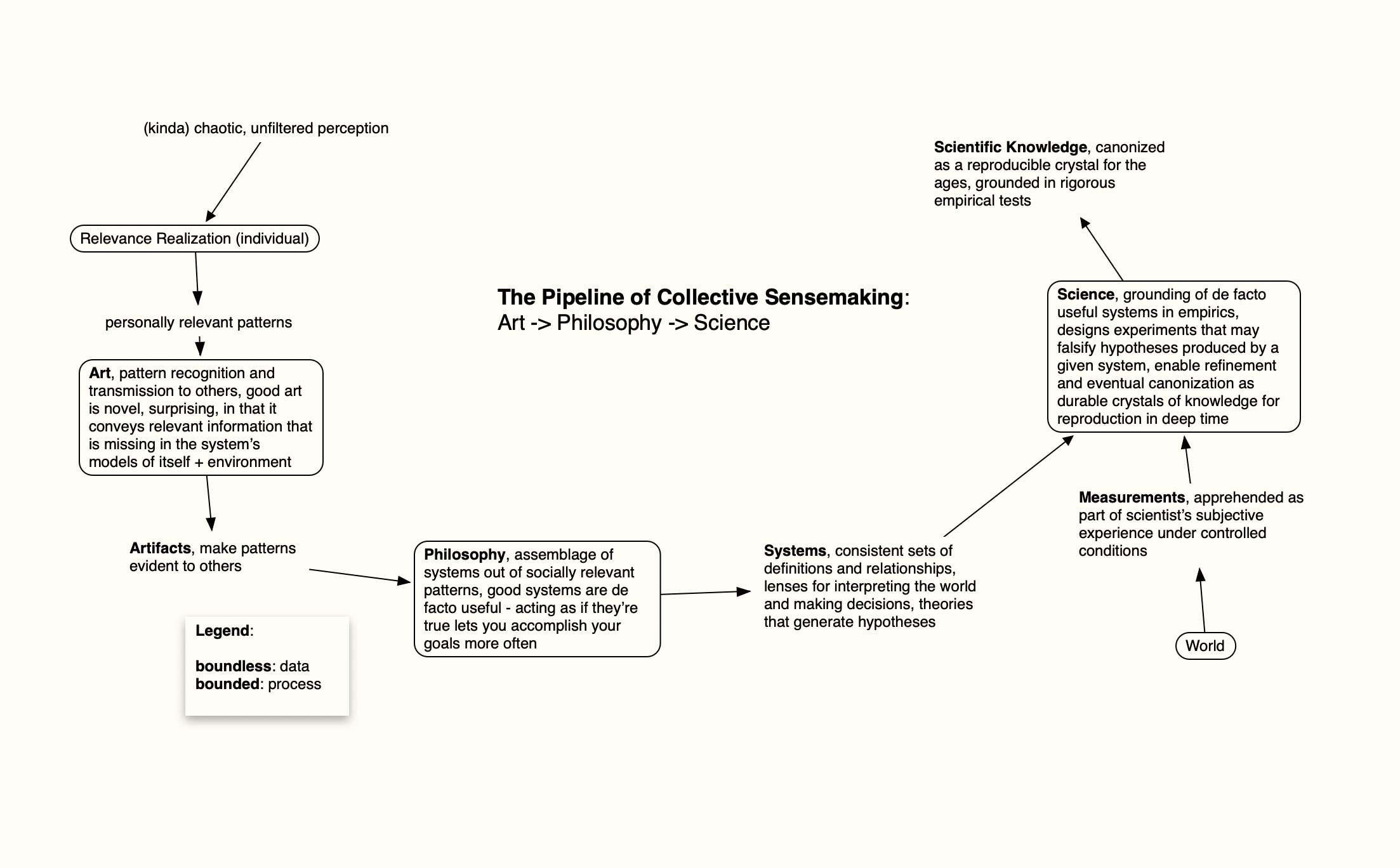The Pipeline of Collective Sensemaking: Art->Philosophy->Science
Art, philosophy, and science are not just isolated domains; they feed into each other. Think of it as a pipeline: art captures raw insights, philosophy structures those insights, and science tests and refines them (of course this is oversimplifying, but while all models are wrong, some are useful). This essay breaks down how each stage of this pipeline contributes to a unified grasp of our shared reality. By understanding this progression, we not only see the tangible value of each stage but also how they collectively propel the human project. If you're intrigued by how we, as a society, synthesize our shared reality, read on.
The free-energy principle (FEP) tells us that organisms try to minimize the surprise between predictions and sensory data, and brains do it by refining models of their environments as they perceive new things. The FEP also helps explain how bigger adaptive systems like society work, and we use it to interpret what art, philosophy and science are doing.
We’re trying to reason about the whole world, the whole human-planetary system that just sort of tries to keep existing by adapting to its environment and growing and maybe generating some beauty along the way. We each get information about the world from our subjective experience; that information gets propagated up the brain and out to our peers and across many levels of aggregation and synthesis. That’s the process of collective sensemaking!

Art as the Genesis of Ideas:
In a societal context, art can be likened to the cognitive process wherein individuals filter and discern meaningful patterns from the plethora of stimuli—a process John Vervaeke describes as 'relevance realization’.
Art pulls patterns from the primordial pools of the unconscious and brings them to collective attention. It not only presents insights but often challenges existing worldviews. This resonance with individuals and society hints at the gaps in our understanding and offers a chance to bridge them.
e.g. Renaissance art shifting theocentric medieval thought to a focus on Humanism; Impressionist art moving away from realism makes it evident that our connection with reality is filtered through individual perception; Surrealism pointing to the irrational but psychoanalytic relevance of dreams and the unconscious.
Once these artistic patterns establish themselves within the societal psyche, they beckon a deeper understanding and integration.
Philosophy as the Formulation of Systems:
As impactful art captures societal attention, it permeates the collective consciousness. Philosophers often systematize these newfound artistic paradigms, clarifying relationships, and tracing implications. These philosophical models not only guide scholarly thought but also permeate our everyday reasoning.
Sometimes, philosophers, (I'm thinking of Jung) will bypass the cultural zeitgeist and turn inward, tapping into deeper or even mystical experiences. These introspections, in essence, can be their personal art that later gets distilled into philosophical constructs.
On their own merit, philosophical systems guide our informal reasoning about the world, offering heuristics for action, and framing inquiries for empirical exploration. They give shape to ideas and the most de facto useful ones end up as scaffolding for empirical investigation by framing the concepts, questions, and problems that science explores and refines.
e.g. Aristotle’s Physics ideas on motion, causation, continuity of space and time provided null hypotheses to then be falsified and refined by Galileo (fall speeds of heavier objects) and Newton (inertia vs natural motion). Descartes’ mind/body dualism spurring the development of cognitive science and the current search for neural correlates of consciousness.
With the frameworks of understanding set by philosophers, a quest begins to test their validity and universal applicability.
Science as Refinement through Experimentation:
The scientific method, in essence, is an evolved form of the brain's natural proclivity to reduce uncertainty. It critically examines the ideas sparked by art and structured by philosophy, demanding empirical evidence and validation. While art provides the spark of an idea and philosophy endeavors to structure it, science demands evidence. Through rigorous experimentation, observations, and analyses, science seeks to confirm or refute these structured ideas, grounding them in empirical reality.
Moreover, science doesn't just validate or refute; it iteratively refines. It takes the broad strokes painted by art and the organized blueprints provided by philosophy and sharpens them, adding nuance and details that were previously overlooked. In doing so, it contributes to the collective knowledge reservoir, crystalizing useful but fuzzy information into an empirically grounded lattice that is stable, potentially into deep time.
Conclusion
Through this lens, we realize the functional importance of the roles of artists and philosophers in the face of a status quo that lionizes science and engineering. Artists delve deep, unearthing the raw materials of sensemaking. Philosophers sculpt these insights into actionable frameworks and worldviews. Scientists then refine, grounding these ideas in empirical reality.
As in permaculture, where the 'edge effect' speaks to the fertile intersection of two domains, we could recognize and nurture the intersections of art, philosophy, and science. By honoring these interfaces, we ensure our turbo-charged science and engineering are anchored in the very essence of human experience, which (in my opinion) should be the core of efforts.